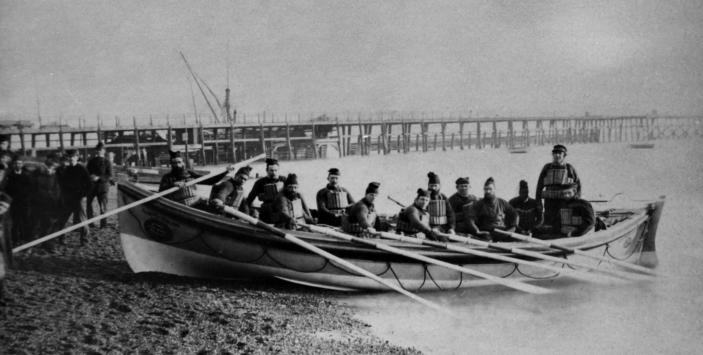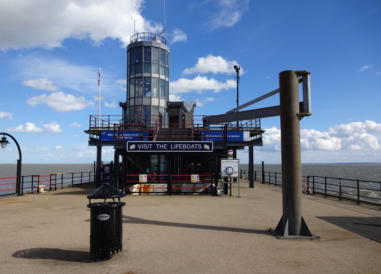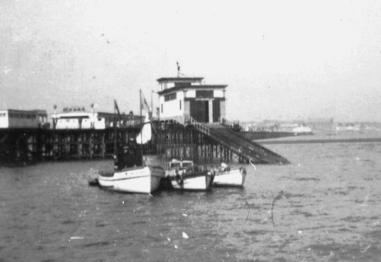Southend Lifeboats

The
Boys
of
England
and
Edwin
J.
Brett
Lifeboat,
and
crew
beached
at
Southend
with
the
wooden
Pier
in
the
background. Image from the Terry Herbert Collection
Southend-on-Sea

1879 - 1891 Boys of England and Edwin J. Brett. Gift of the Boys of England Lifeboat Fund.
The
first
lifeboat
sent
to
Southend
cost
£350,
the
majority
of
the
cost
was
raised
through
a
fund
in
a
magazine
called
the
Boys
of
England.
Edwin
Brett,
the
publications
owner
visited
Southend
in
November
1879
to
christen
the
boat
bearing
his
name.
The
vessel
was
primarily
designed
for
rowing,
24
feet
in
length
and
self-righting.
The
vessel
was
stationed
at
the
Pier
Head,
from
which
it
was
launched
on
davits.
Reverend
Frederick
Thackeray
(who
was
a
member
of
the
local
Board
and
cousin
of
the
author
William
Makepeace
Thakeray)
vicar
of
Shopland
who
lived
at
9
Royal
Terrace,
lost
his
eldest
son
also
called
Frederick
by
drowning
at
sea
in
1867.
In
1876
the
RNLI
had
stationed
a
lifeboat
at
Harwich
called
the
Springwell.
After
representations
from
Rev
Thackeray
a
lifeboat was sent to Southend 1879, he would become the chairman of the lifeboat committee.
1885
-
1899
Theadore
and
Herbert.
Legacy
of
Mrs
F.
S.
Smith,
of
Lisheen,
Cork.
(From
1885
-
1891
there
were
two
boats
at
the
station).
On
8th
October
1885
a
new
lifeboat
came
to
Southend
from
the
RNLI.
The
town
was
decorated
and
a
procession
included
the
Southend
Drum
and
Fife
band;
the
band
of
the
Royal
Artillery
School
of
gunnery;
members
of
the
local
board
and
various
organisations.
The
lifeboat
was
trolley
drawn
by
six
horses
and
taken
to
Vandervord’s
Hard
where
a
service
was
conducted
by
Rev
T.
W. Herbert. Mrs Thackeray, wife of Rev Thackeray, chairman of the lifeboat committee, named the lifeboat with a bottle of wine.
1889 - 1923 James Stevens, No 9. Legacy of Mr James Stevens of Birmingham.
1923 - 1924 Reserve Lifeboat.
1924 - 1928 Charlie Medland. Legacy of Mrs C. B. Medland, of Clapham.
1928 - 1955 Greater London (Motor Lifeboat). Gift of the Civil Service Lifeboat Fund.
This
motor
lifeboat,
was
of
the
Ramsgate
type,
a
type
specially
designed
in
1926
for
stations
where
the
lifeboat
has
to
travel
considerable
distances
and
to
work
in
shallow
water
among
sandbanks.
The
vessel
was
48ft.
6in.
by
13ft.,
and
was
driven
by
two
40hp
engines.
Speed
of
8
¼
knots
and
could
travel
140
miles
at
full
speed
without
refuelling.
A
crew
of
nine
could
be
carried,
and
was
equipped
with
a
search
light
and
line
throwing
gun,
she
cost
£8,417.
The
“Greater
London”
was
one
of
the
19
lifeboats
which
went to Dunkirk in 1940.
1934 Reserve Lifeboat.
1935,
February.
The
new
lifeboat
house
and
slipway
were
completed.
The
new
lifeboat
house
was
located
on
a
raised
platform
on
a
spur to the east of the pier, the lifeboat was launched into the sea via a slipway.
The
boathouse
measured
68ft.
6in.
by
25ft.
6in.
was
of
concrete
and
timber
construction,
the
whole
structure
was
carried
on
braced
columns of cast iron, mounted on 52 concrete piles which were screwed into the sea-bed.
The
slipway
was
176
feet
long
from
the
front
of
the
boathouse,
and
had
a
gradient
of
1
in
6.
Inside
the
house
was
a
tipping
cradle,
so
that
the
lifeboat
lies
on
a
level
keel
when
she
was
in
the
house,
and
this
cradle
was
tilted
to
the
gradient
of
the
slipway
when
the
boat
was launched. She was hauled up the slipway by an electric winch. The slipway was floodlit for night launches.
1935, 23rd July. The Pier’s centenary. Unveiling of a tablet on the boat house
and official opening of the slipway by the Chairman of the Port of London
Authority Lord Ritchie of Dundee. The lifeboat house would serve until 1986
when it was damaged beyond repair by the Kings Abbey accident.
1937 Reserve Lifeboat.
1955
The
“Greater
London
II”,
a
Watson
class
boat
replaces
the
original
Greater London.
1957
The
“Greater
London”
out
of
service
and
sold
to
South
America,
to
operate as a lifeboat.
1976,
25th
March.
RNLI
Lifeboat
"Greater
London
II"
retired
and
all
sea
going
lifeboat
operations
were
ceased
due
to
the
silting
up
of
the
River
Thames
around
the
lifeboat
slip-way,
operations
were
replaced
by
an
Atlantic 21 semi-rigid inflatable, named the “Percy Garon.”
1986
The
“Percy
Garon
II”
arrives,
a
new
Atlantic
21,
which
was
named
by
HRH
Princess
Anne
on
2nd
May.
Shortly
afterwards
disaster
struck
the
lifeboat
station
when
the
“Kings
Abbey”
sliced
through
the
Pier
between
the
old
and
new
Pier
Heads
on
30th
June
1986.
Not
great
timing
with
the
height
of
the
season
just
around
the
corner.
But
as
tends
to
be
with
the
pier
calamities
they
in
themselves
become
an
attraction
that
brings
the
public
out
to
support
the
old
structure.
This
time
the
tanker
severed
the
lifeboat
slipway,
caused
irreparable
damage
to
the
boathouse
and
left
a
70ft
gap
in
the
Pier.
A
temporary
station
was
quickly
re-established
at
the
pier
head.
Repairs
followed
in
1989,
with
a
new
café
and
toilets
opening
on
the
stem
extension.
1991,
24th
January.
A
rebuilt
lifeboat
house
is
officially
opened
by
HRH
The
Princess Royal.
2002.
New
lifeboat
station
opens
as
part
of
the
regeneration
of
the
Pier
Head.
2013, 16th July. An inshore boathouse was officially opened.

2016 Pier Head Lifeboat Station

1948 Pier Head Lifeboat Station
Southend Timeline Southend-on-Sea © 2009 - 2024. All Rights Reserved



SOUTHEND CITY

Southend-on-Sea’s No 1 History Website! Documenting The Town & The Townspeople
Now Incorporating The Sea Of Change Website
Website Info:


Chalkwell ▪ Eastwood ▪ Leigh-on-Sea ▪ Prittlewell ▪ Shoeburyness ▪ Southchurch ▪ Thorpe Bay ▪ Westcliff-on-Sea
































































